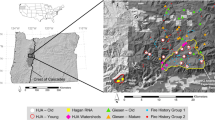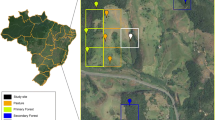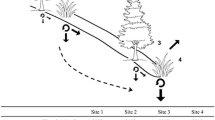Abstract
Nutrient availability varies substantially across lowland tropical forests and constrains their responses to global change. However, interactions among regional, landscape, and local controls of nutrient availability are poorly understood. In that context, we explored the effects of rainfall, topography, and canopy chemistry on nitrogen (N) cycling across the Osa Peninsula (Costa Rica). We sampled soils from catenas in regions receiving 3000 versus 5000 mm y−1 rainfall. In both regions, we sampled catenas starting on narrow, knife-edged ridges, and in the less humid region we compared catenas starting on rapidly eroding knife-edged ridges to catenas with ridges consisting of slowly eroding terraces. On the stable terraces, we sampled soils from 0.25 ha plots with either high or low mean canopy N. In all sites, we measured metrics of long- (soil δ15N) and short-term (net nitrification, net N mineralization, and KCl-extractable N) N availability. Mean soil δ15N was elevated in the less humid region (3.8 ± 0.16 vs. 3.1 ± 0.14‰; P = 0.003). Within that region, mean δ15N was enriched by approximately 1‰ on stable terraces (5.3 ± 0.14‰) relative to nearby knife-edged ridges (4.0 ± 0.24‰; P < 0.001). Short-term N metrics did not vary with rainfall or topography (P > 0.05). By contrast, short-term soil N metrics differed under canopies with high versus low canopy N, but soil δ15N did not. These results illustrate the role of climate and topography as dominant drivers of long-term N cycling in the region, as well as the potential for canopy characteristics, which are likely determined by species composition in this system, to impose small-scale heterogeneity within those broader constraints. Overall, our work suggests the utility of a hierarchical framework for understanding how diverse drivers of nutrient status interact across space and time in tropical forests.





Similar content being viewed by others
References
Adamek M, Corre MD, Hölscher D. 2009. Early effect of elevated nitrogen input on above-ground net primary production of a lower montane rain forest, Panama. Journal of Tropical Ecology 25:637–47.
Alvarez-Clare S, Mack MC, Brooks M. 2013. A direct test of nitrogen and phosphorus limitation to net primary productivity in a lowland tropical wet forest. Ecology 94:1540–51.
Amundson R, Austin AT, Schuur EAG, Yoo K, Matzek V, Kendall C, Uebersax A, Brenner D, Baisden WT. 2003. Global patterns of the isotopic composition of soil and plant nitrogen. Global Biogeochemical Cycles 17:1031.
Asner GP, Knapp DE, Boardman J, Green RO, Kennedy-Bowdoin T, Eastwood M, Martin RE, Anderson C, Field CB. 2012. Carnegie Airborne Observatory-2: increasing science data dimensionality via high-fidelity multi-sensor fusion. Remote Sensing of Environment 124:454–65.
Asner GP, Martin RE, Anderson CB, Knapp DE. 2015. Quantifying forest canopy traits: imaging spectroscopy versus field survey. Remote Sensing of Environment 158:15–27.
Asner GP, Martin RE, Tupayachi R, Anderson CB, Sinca F, Carranza-Jiménez L, Martinez P. 2014. Amazonian functional diversity from forest canopy chemical assembly. Proceedings of the National Academy of Sciences of the United States of America 111:5604–9.
Asner GP, Martin RE. 2016. Convergent elevation trends in canopy chemical traits of tropical forests. Global Change Biology 22:2216–27.
Balzotti CC, Asner GP, Taylor PG, Cleveland CC, Cole R, Marin R, Nasto MK, Osborne BB, Porder S, Townsend AR. 2016. Environmental controls on canopy foliar N distribution in a Neotropical lowland forest. Ecol Appl 26:2449–62.
Bern CR, Townsend AR, Farmer GL. 2005. Unexpected dominance of parent-material strontium in a tropical forest on highly weathered soils. Ecology 86:626–32.
Binkley D, Giardina C. 1998. Why do tree species affect soils? The warp and woof of tree-soil interactions. Biogeochemistry 42:89–106.
Bonan GB, Levis S. 2010. Quantifying carbon-nitrogen feedbacks in the Community Land Model (CLM4). Geophysical Research Letters 37:1–6.
Buchs DM, Baumgartner PO, Baumgartner-Mora C, Bandini AN, Jackett SJ, Diserens MO, Stucki J. 2009. Late Cretaceous to Miocene seamount accretion and melange formation in the Osa and Burica Peninsulas (Southern Costa Rica): episodic growth of a convergent margin. Geological Society Special Publication 328:411–56.
Burghouts TBA, Van Straalen NM, Bruijnzeel LA. 1998. Spatial heterogeneity of element and litter turnover in a Bornean rain forest. Journal of Tropical Ecology 44:477–506.
Cleveland CC, Houlton BZ, Smith WK, Marklein AR, Reed SC, Parton W, Del Grosso SJ, Running SW. 2013. Patterns of new versus recycled primary production in the terrestrial biosphere. Proceedings of the National Academy of Sciences 110:12733–7.
Cleveland CC, Reed SC, Townsend AR. 2006. Nutrient regulation of organic matter decomposition in a tropical rain forest. Ecology 87:492–503.
Cleveland CC, Townsend AR, Taylor P, Alvarez-Clare S, Bustamante MMC, Chuyong G, Dobrowski SZ, Grierson P, Harms KE, Houlton BZ, Marklein A, Parton W, Porder S, Reed SC, Sierra CA, Silver WL, Tanner EVJ, Wieder WR. 2011. Relationships among net primary productivity, nutrients and climate in tropical rain forest: a pan-tropical analysis. Ecology letters 14:939–47.
Cleveland CC, Townsend AR. 2006. Nutrient additions to a tropical rain forest drive substantial soil carbon dioxide losses to the atmosphere. Proceedings of the National Academy of Sciences 103:10316–21.
Condit R, Engelbrecht BMJ, Pino D, Pérez R, Turner BL. 2013. Species distributions in response to individual soil nutrients and seasonal drought across a community of tropical trees. Proceedings of the National Academy of Sciences of the United States of America 110:5064–8.
Craine JM, Elmore AJ, Aidar MPM, Bustamante M, Dawson TE, Hobbie EA, Kahmen A, MacK MC, McLauchlan KK, Michelsen A, Nardoto GB, Pardo LH, Peñuelas J, Reich PB, Schuur EAG, Stock WD, Templer PH, Virginia RA, Welker JM, Wright IJ. 2009. Global patterns of foliar nitrogen isotopes and their relationships with climate, mycorrhizal fungi, foliar nutrient concentrations, and nitrogen availability. New Phytologist 183:980–92.
Dent DH, Bagchi R, Robinson D, Majalap-Lee N, Burslem DFRP. 2006. Nutrient fluxes via litterfall and leaf litter decomposition vary across a gradient of soil nutrient supply in a lowland tropical rain forest. Plant and Soil 288:197–215.
Feilhauer H, Asner GP, Martin RE, Schmidtlein S. 2010. Brightness-normalized partial least squares regression for hyperspectral data. Journal of Quantitative Spectroscopy and Radiative Transfer 111:1947–57.
Haaland DM, Thomas EV. 1988. Partial least-squares methods for spectral analyses. 1. Relation to other quantitative calibration methods and the extraction of qualitative information. Analytical Chemistry 60:1193–202.
Hall SJ, Matson PA. 2003. Nutrient status of tropical rain forest influences soil N dynamics after N additions. Ecological Monographs 73:107–29.
Handley LL, Austin AT, Scrimgeour CM, Raven JA, Heaton THE, Schmidt S, Stewart GR. 1999. The 15 N-natural abundance of ecosystem samples reflects measures of water availability. Australian Journal of Plant Physiology 26:185–99.
Hauff F, Hoernle K, van den Bogaard P, Alvarado G, Garbe-Schönberg D. 2000. Age and geochemistry of basaltic complexes in western Costa Rica: contributions to the geotectonic evolution of Central America. Geochemistry Geophysics Geosystems 1:1009.
Hidaka A, Kitayama K. 2011. Allocation of foliar phosphorus fractions and leaf traits of tropical tree species in response to decreased soil phosphorus availability on Mount Kinabalu, Borneo. Journal of Ecology 99:849–57.
Hilton RG, Galy A, West AJ, Hovius N, Roberts GG. 2013. Geomorphic control on the δ15N of mountain forests. Biogeosciences 10:1693–705.
Hobbie SE, Reich PB, Oleksyn J, Ogdahl M, Zytkowiak R, Hale C, Karolewski P. 2006. Tree species effects on decomposition and forest floor dynamics in a common garden. Ecology 87:2288–97.
Houlton BZ, Sigman DM, Hedin LO. 2006. Isotopic evidence for large gaseous nitrogen losses from tropical rainforests. Proceedings of the National Academy of Sciences of the United States of America 103:8745–50.
Houlton BZ, Sigman DM, Schuur EAG, Hedin LO. 2007. A climate-driven switch in plant nitrogen acquisition within tropical forest communities. Proceedings of the National Academy of Sciences of the United States of America 104:8902–6.
Ilstedt U, Singh S. 2005. Nitrogen and phosphorus limitations of microbial respiration in a tropical phosphorus-fixing acrisol (ultisol) compared with organic compost. Soil Biology and Biochemistry 37:1407–10.
Jenny H, Arkley RJ, Schultz AM. 1969. The pygmy forest-podsol ecosystem and its dune associates of the Mendocino coast. Madrono 20:60–74.
Jenny H. 1941. Factors of soil formation: a system of quantitative pedology. New York, NY: McGraw-Hill.
John R, Dalling JW, Harms KE, Yavitt JB, Stallard RF, Mirabello M, Hubbell SP, Valencia R, Navarrete H, Vallejo M, Foster RB. 2007. Soil nutrients influence spatial distributions of tropical tree species. PNAS 104:864–9.
Kappelle M, Castro M, Acevedo H, Gonzáles L, Monge H. 2003. Ecosistemas del área de conservación Osa (ACOSA). San Jose, Costa Rica: Instituto Nacional de Biodiversidad.
Kaspari M, Garcia MN, Harms KE, Santana M, Wright SJ, Yavitt JB. 2008. Multiple nutrients limit litterfall and decomposition in a tropical forest. Ecology Letters 11:35–43.
Keller AB, Reed SC, Townsend AR, Cleveland CC. 2013. Effects of canopy tree species on belowground biogeochemistry in a lowland wet tropical forest. Soil Biology and Biochemistry 58:61–9.
Laughlin DC, Richardson SJ, Wright EF, Bellingham PJ. 2015. Environmental filtering and positive plant litter feedback simultaneously explain correlations between leaf traits and soil fertility. Ecosystems 18:1269–80.
Lovett G, Weathers K, Arthur M, Schultz J. 2004. Nitrogen cycling in a northern hardwood forest: do species matter? Biogeochemistry 67:289–308.
Malhi Y, Wright J. 2004. Spatial patterns and recent trends in the climate of tropical rainforest regions. Philosophical transactions of the Royal Society of London Series B, Biological sciences 359:311–29.
Martinelli LA, Piccolo MC, Townsend AR, Vitousek PM, Cuevas E, McDowell W, Robertson GP, Santos OC, Treseder K. 1999. Nitrogen stable isotopic composition of leaves and soil: tropical versus temperate forests. Biogeochemistry 46:45–65.
Mayor JR, Wright SJ, Schuur EAG, Brooks ME, Turner BL. 2014a. Stable nitrogen isotope patterns of trees and soils altered by long-term nitrogen and phosphorus addition to a lowland tropical rainforest. Biogeochemistry 119:293–306.
Mayor JR, Wright SJ, Turner BL. 2014b. Species-specific responses of foliar nutrients to long-term nitrogen and phosphorus additions in a lowland tropical forest. Journal of Ecology 102:36–44.
McGroddy ME, Daufresne T, Hedin LO. 2004. Scaling of C:N:P stoichiometry in forests worldwide: implications of terrestrial Redfield-type ratios. Ecology 85:2390–401.
Mirmanto E, Proctor J, Green J, Nagy L, Suriantata . 1999. Effects of nitrogen and phosphorus fertilization in a lowland evergreen rainforest. Philosophical transactions of the Royal Society of London Series B, Biological sciences 354:1825–9.
Nardoto GB, Ometto JPHB, Ehleringer JR, Higuchi N, Bustamante MMDC, Martinelli LA. 2008. Understanding the influences of spatial patterns on N availability within the Brazilian Amazon forest. Ecosystems 11:1234–46.
Oksanen J, Blanchet FG, Kindt R, Legendre P, Minchin PR, O’Hara RB, Simpson GL, Solymos P, Henry M, Stevens H, Wagner H. 2016. vegan: Community Ecology Package. R package version 2.3–5. http://cran.r-project.org/package=vegan.
Perez S, Alvarado A, Ramirez E. 1978. Manual descriptivo del mapa de asociaciones de subgrupos de suelos de Costa Rica: (escala 1:200000). San Jose, Costa Rica: Oficina de Plantification Sectorial Agropecuario.
Porder S, Asner GP, Vitousek PM. 2005. Ground-based and remotely sensed nutrient availability across a tropical landscape. Proceedings of the National Academy of Sciences of the United States of America 102:10909–12.
Porder S, Hilley GE. 2011. Linking chronosequences with the rest of the world: predicting soil phosphorus content in denuding landscapes. Biogeochemistry 102:153–66.
Porder S, Johnson AH, Xing HX, Brocard G, Goldsmith S, Pett-Ridge J. 2015. Linking geomorphology, weathering and cation availability in the Luquillo Mountains of Puerto Rico. Geoderma 249–250:100–10.
Powers JS, Kalicin MH, Newman ME. 2004. Tree species do not influence local soil chemistry in a species-rich Costa Rica rain forest. Journal of Tropical Ecology 20:587–90.
Reed SC, Cleveland CC, Townsend AR. 2008. Tree species control rates of free-living nitrogen fixation in a tropical rain forest. Ecology 89:2924–34.
Schuur EA, Matson PA. 2001. Net primary productivity and nutrient cycling across a mesic to wet precipitation gradient in Hawaiian montane forest. Oecologia 128:431–42.
Schuur EAG, Chadwick OA, Matson PA. 2001. Carbon cycling and soil carbon storage in mesic to wet Hawaiian montane forests. Ecology 82:3182–96.
Schuur EAG. 2003. Productivity and global climate revisited: the sensitivity of tropical forest growth to precipitation. Ecology 84:1165–70.
Sprent JI. 2009. Legume Nodulation: A Global Perspective. Oxford, UK: Wiley-Blackwell.
Taylor P, Asner G, Dahlin K, Anderson C, Knapp D, Martin R, Mascaro J, Chazdon R, Cole R, Wanek W, Hofhansl F, Malavassi E, Vilchez-Alvarado B, Townsend A. 2015. Landscape-scale controls on aboveground forest carbon stocks on the Osa Peninsula, Costa Rica. Plos One 10:e0126748.
Thornton PE, Lamarque JF, Rosenbloom NA, Mahowald NM. 2007. Influence of carbon-nitrogen cycle coupling on land model response to CO2 fertilization and climate variability. Global Biogeochemical Cycles 21:1–15.
Townsend AR, Asner GP, Cleveland CC. 2008. The biogeochemical heterogeneity of tropical forests. Trends in Ecology and Evolution 23:424–31.
Townsend AR, Cleveland CC, Houlton BZ, Alden CB, White JWC. 2011. Multi-element regulation of the tropical forest carbon cycle. Frontiers in Ecology and the Environment 9:9–17.
Van Haren JLM, De Oliveira RC, Restrepo-Coupe N, Hutyra L, De Camargo PB, Keller M, Saleska SR. 2010. Do plant species influence soil CO2 and N2O fluxes in a diverse tropical forest? Journal of Geophysical Research: Biogeosciences 115:1–9.
Vasquez M. 1989. Mapa de suelos de Costa Rica. Scale 1:200.000. San Jose, Costa Rica.
Vitousek P, Chadwick O, Matson P, Allison S, Derry L, Kettley L, Luers A, Mecking E, Monastra V, Porder S. 2003. Erosion and the rejuvenation of weathering-derived nutrient supply in an old tropical landscape. Ecosystems 6:762–72.
Vitousek PM. 1984. Litterfall, nutrient cycling, and nutrient limitation in tropical forests. Ecology 65:285–98.
Vitousek PM. 2004. Nutrient cycling and limitation: Hawai’i as a model system. Princeton, New Jersey: Princeton University Press.
Wang YP, Law RM, Pak B. 2010. A global model of carbon, nitrogen and phosphorus cycles for the terrestrial biosphere. Biogeosciences 7:2261–82.
Waring ABG, Álvarez-Cansino L, Barry K, Becklund KK, Gei MG, Lopez O, Markesteijn L, Mangan S, RodrÍguez ME, Segnitz RM, Schnitzer SA, Powers JS. 2015. Pervasive and strong effects of plant individuals and species on soil chemistry: a meta-analysis of individual plant ‘Zinke’ effects. Proceedings of the Royal Society B 282:1–8.
Weintraub SR, Taylor PG, Porder S, Cleveland CC, Asner GP, Townsend AR. 2015. Topographic controls on nitrogen availability in a lowland tropical forest. Ecology 96:1561–74.
White AF, Schulz MS, Stonestrom DA, Vivit DV, Fitzpatrick J, Bullen TD, Maher K, Blum AE. 2009. Chemical weathering of a marine terrace chronosequence, Santa Cruz, California. Part II: solute profiles, gradients and the comparisons of contemporary and long-term weathering rates. Geochimica et Cosmochimica Acta 73:2769–803.
Wieder W, Cleveland CC, Townsend AR. 2009. Controls over leaf litter decomposition in wet tropical forests. Ecology 90:3333–41.
Wieder WR, Cleveland CC, Smith WK, Todd-Brown K. 2015. Future productivity and carbon storage limited by terrestrial nutrient availability. Nature Geoscience 8:441–4.
Wieder WR, Cleveland CC, Townsend AR. 2008. Tropical tree species composition affects the oxidation of dissolved organic matter from litter. Biogeochemistry 88:127–38.
Wieder WR, Cleveland CC, Townsend AR. 2011. Throughfall exclusion and leaf litter addition drive higher rates of soil nitrous oxide emissions from a lowland wet tropical forest. Global Change Biology 17:3195–207.
Wright SJ, Yavitt JB, Wurzburger N, Turner BL, Tanner VJ, Sayer EJ, Santiago LS, Kaspari M, Hedin LO, Harms KE, Garcia MN, Corre MD, Yavitt B, Turner L, Tanner VJ, Garcia N, Harms E, Sayer J, Santiago S. 2011. Potassium, phosphorus, or nitrogen limit root allocation, tree growth, or litter production in a lowland tropical forest. Ecology 92:1616–25.
Xia S-W, Chen J, Schaefer D, Detto M. 2015. Scale-dependent soil macronutrient heterogeneity reveals effects of litterfall in a tropical rainforest. Plant and Soil 391:51–61.
Acknowledgements
This work was supported through a collaborative Grant awarded by the National Science Foundation (DEB-0918387 to SP), and an IGERT (DGE-0966060 to D. Rand). Carnegie Airborne Observatory (CAO) data collection and processing was funded privately by the Carnegie Institution for Science. The CAO has been made possible by grants and donations to G.P. Asner from the Avatar Alliance Foundation, Margaret A. Cargill Foundation, David and Lucile Packard Foundation, Gordon and Betty Moore Foundation, Grantham Foundation for the Protection of the Environment, W. M. Keck Foundation, John D. and Catherine T. MacArthur Foundation, Andrew W. Mellon Foundation, Mary Anne Nyburg Baker and G. Leonard Baker Jr, and William R. Hearst III. From the Carnegie Airborne Observatory, we thank R. Martin, C. Anderson, D. Knapp and N. Vaughn for assistance with data collection and processing. We thank Osa Conservation and the Ministeria de Ambiente y Energía for assistance with research permits and site access. The authors appreciate field and laboratory assistance from M. Lopez as well as B. Cannon, A. Ginter, B. Munyer, A. Swanson and R. Ho. Funding was provided by Blue Moon Foundation.
Author information
Authors and Affiliations
Corresponding author
Additional information
Author contributions
All authors conceived of or designed the study. BBO, MKN, PGT and CSB performed the research and analyzed the data. BBO and SP wrote the first draft, and all other authors edited and helped revise the manuscript.
Electronic supplementary material
Below is the link to the electronic supplementary material.
Rights and permissions
About this article
Cite this article
Osborne, B.B., Nasto, M.K., Asner, G.P. et al. Climate, Topography, and Canopy Chemistry Exert Hierarchical Control Over Soil N Cycling in a Neotropical Lowland Forest. Ecosystems 20, 1089–1103 (2017). https://doi.org/10.1007/s10021-016-0095-7
Received:
Accepted:
Published:
Issue Date:
DOI: https://doi.org/10.1007/s10021-016-0095-7




